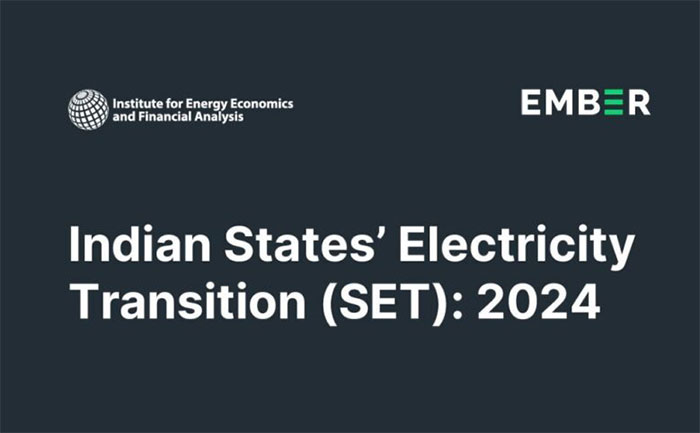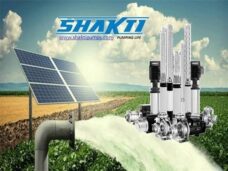Highlights :
- Kerala, Haryana, Andhra Pradesh, Punjab and Himachal Pradesh all showed strong progress in two dimensions – Decarbonisation and Readiness and Performance of the Power Ecosystem. However, their performance in the Market Enablers dimension was not as strong as other states, which may affect their ability to drive further decarbonisation.

Karnataka and Gujarat continued to showcase their leadership in the progress toward the clean energy transition, a new joint report by the Institute for Energy Economics and Financial Analysis (IEEFA) and Ember shows.
This marks the second year of IEEFA and Ember collaboration on the Indian States’ Electricity Transition (SET) report, which evaluates the clean electricity transition preparedness at the subnational level. In 2024, the report adds five more states, totalling 21 states and representing about 95% of India’s annual power demand in the past seven financial years (FY) 2018 to 2024 (up to November). This year, the assessment parameters have been updated to better align with states’ electricity transition progress, incorporating stakeholder feedback and data availability.
Key Takeaways1. Karnataka and Gujarat, the top performers in 2023, maintained strong performance in 2024. They continue to perform well in power sector decarbonisation and are well-positioned to accelerate the transition with adequate market enablers facilitating further growth. 2. Progress in Jharkhand, Bihar, West Bengal and Uttar Pradesh needs to improve. The pace of electricity transition in these states continued to be comparatively slower than other states, despite changes in our assessment parameters. The states need comprehensive planning to enable power sector transition. 3. Odisha has sufficient market enablers to drive decarbonisation in the power sector. However, its performance has not quite matched its progress in establishing these enabling conditions. 4. Kerala, Haryana, Andhra Pradesh, Punjab and Himachal Pradesh all showed strong progress in two dimensions – Decarbonisation and Readiness and Performance of the Power Ecosystem. However, their performance in the Market Enablers dimension was not as strong as other states, which may affect their ability to drive further decarbonisation. |
Despite the changes, Karnataka and Gujarat showcased strong performance across dimensions, effectively integrating renewable energy sources into their power sectors, making strong strides in decarbonisation. But progress in states like Jharkhand, Bihar, West Bengal and Uttar Pradesh needs to improve, similar to last year’s findings. While these states are in the early stages of their transition, they now need to focus on increasing renewable energy deployment, enhancing short term market participation and strengthening their distribution companies.
The report releases when temperatures in India have started to soar, leading to the Ministry of Power preparing for a projected peak power demand of 260 gigawatts. Harsh summers also offer the chance to utilise more clean energy like solar power. Although, this requires the preparedness of states to transition to clean sources of electricity.
“Cyclical weather conditions coupled with faster economic activity is pushing India’s peak electricity demand higher every year. While the central government is taking steps to integrate more renewable energy into the grid, states, too, need to be prepared to do so. Gauging subnational progress now requires constant monitoring of several parameters at the state level. A purely national overview can often overshadow subtle intricacies at the state level, which may stymie the country’s electricity transition,” says the report’s contributing author, Vibhuti Garg, Director – South Asia, IEEFA.
The report finds that while the national-level progress towards the electricity transition is progressing well, it is far more uneven at the state level. “Some states have developed progressive steps, such as boosting decentralised renewable energy deployment, promoting solar pumps for agricultural needs, and enhancing storage solutions to ensure more renewable energy in their electricity systems. But, the transition to clean electricity is still in its infancy in many states. These states should look to accelerate the efforts to access the benefits of a transition to clean electricity and to ensure that they are not left too far behind the better-performing states,” says the report’s contributing author, Aditya Lolla, Asia Programme Director, Ember.
One of the striking findings from the analysis for the 2024 report was that several states are exhibiting preparedness to embrace electricity transition. They perform well in the Readiness and Performance of the Power Ecosystem and Market Enablers dimensions but need to improve in the Decarbonisation dimension.
“Delhi’s power system is well-prepared for decarbonisation, while Odisha has robust market enablers to support decarbonisation in the power sector. However, their actual decarbonisation progress so far does not match their strengths in these aspects, highlighting the importance of performing well in both dimensions to effectively achieve decarbonisation goals,” says co-author Neshwin Rodrigues, Electricity Policy Analyst, Ember.
The report also notes that state-level decarbonisation can be further accelerated by strengthening the power ecosystem and having the right enablers. Some states that are decarbonising well also lack the right market enablers, others struggle with the readiness of their power ecosystems. “Kerala, Haryana, Andhra Pradesh, Punjab and Maharashtra all exhibited considerable progress in certain aspects but also lower performance in other aspects. For example, Kerala and Punjab need to improve when it comes to market enablers for decarbonisation, while Andhra Pradesh and Maharashtra need to focus on the readiness of their power ecosystems,” says co-author Tanya Rana, Energy Analyst, IEEFA.
“Despite achieving relative success in decarbonising the sector thus far, states must address deficiencies in readiness and market enablers to sustain their momentum,” says Saloni Sachdeva Michael, Energy Specialist, India Clean Energy Transition, IEEFA.
The report recognises the considerable efforts that states are making towards transitioning to clean electricity and, thus, recommends some key steps to accelerate the pace of transition. “We recommend the strengthening of state-level regulatory ecosystems. This not only ensures compliance but also promotes growth, data tracking and monitoring, and a conducive environment for business,” says Michael. “India has formulated many central and state-level policy schemes to reinforce its goal of energy independence by supporting various reforms and regulatory interventions across the value chain. However, actual implementation has not been adequate and transparent,” she adds.






























